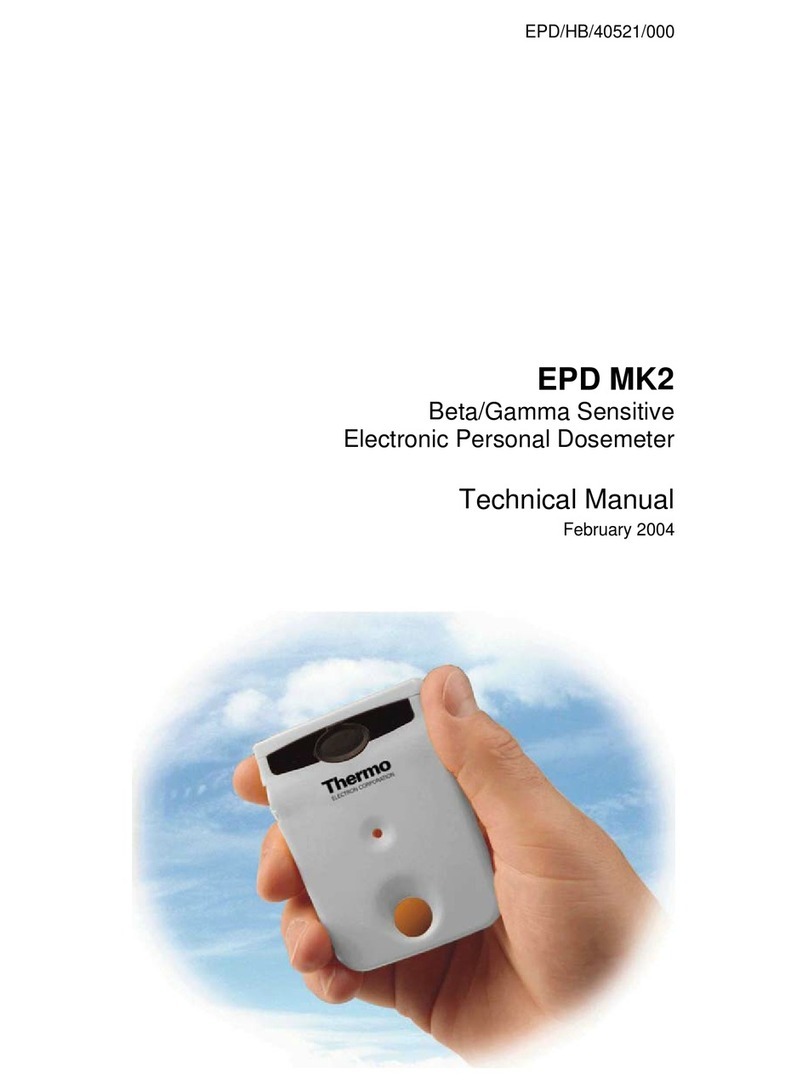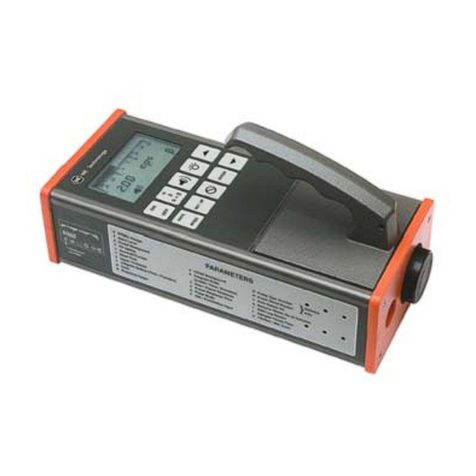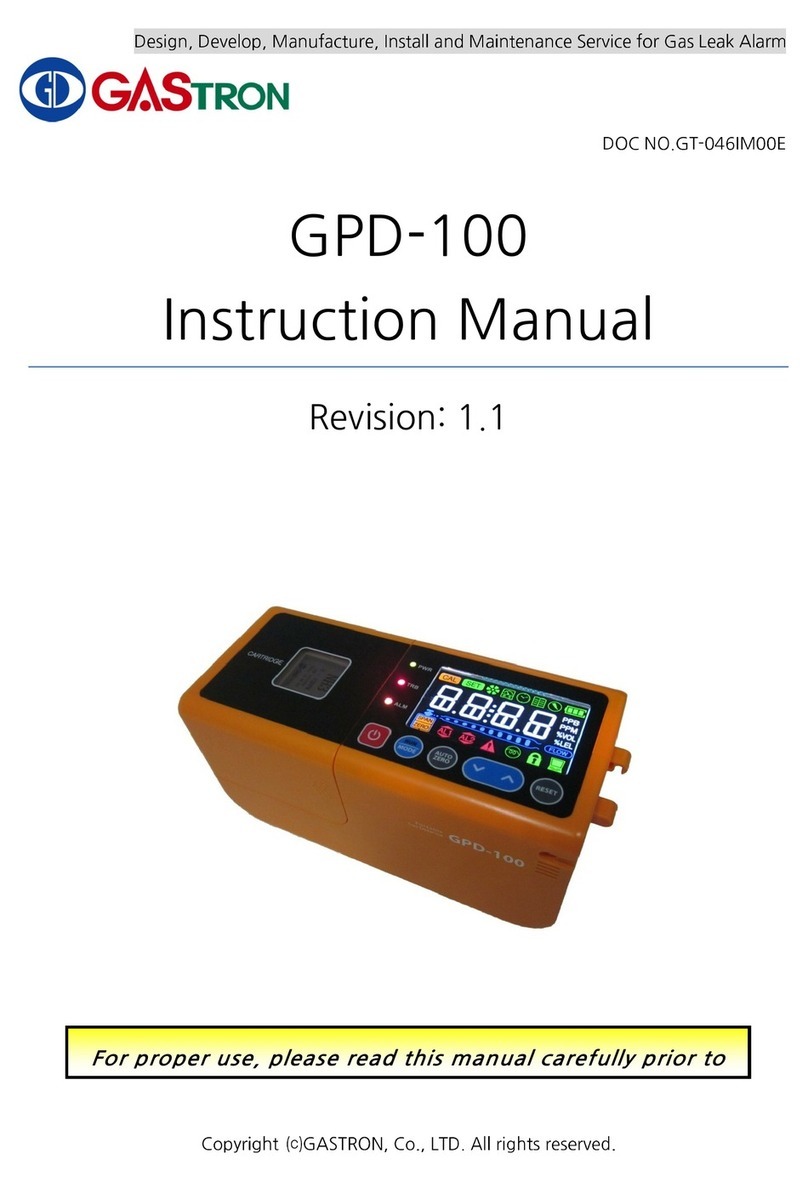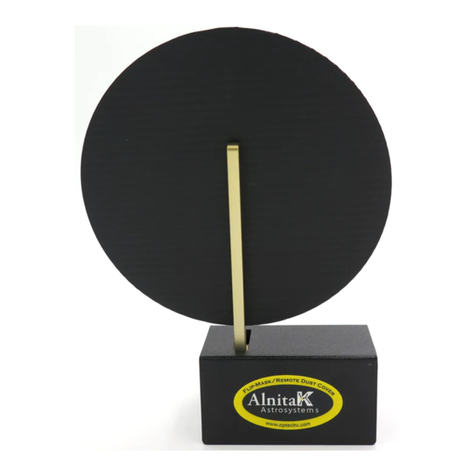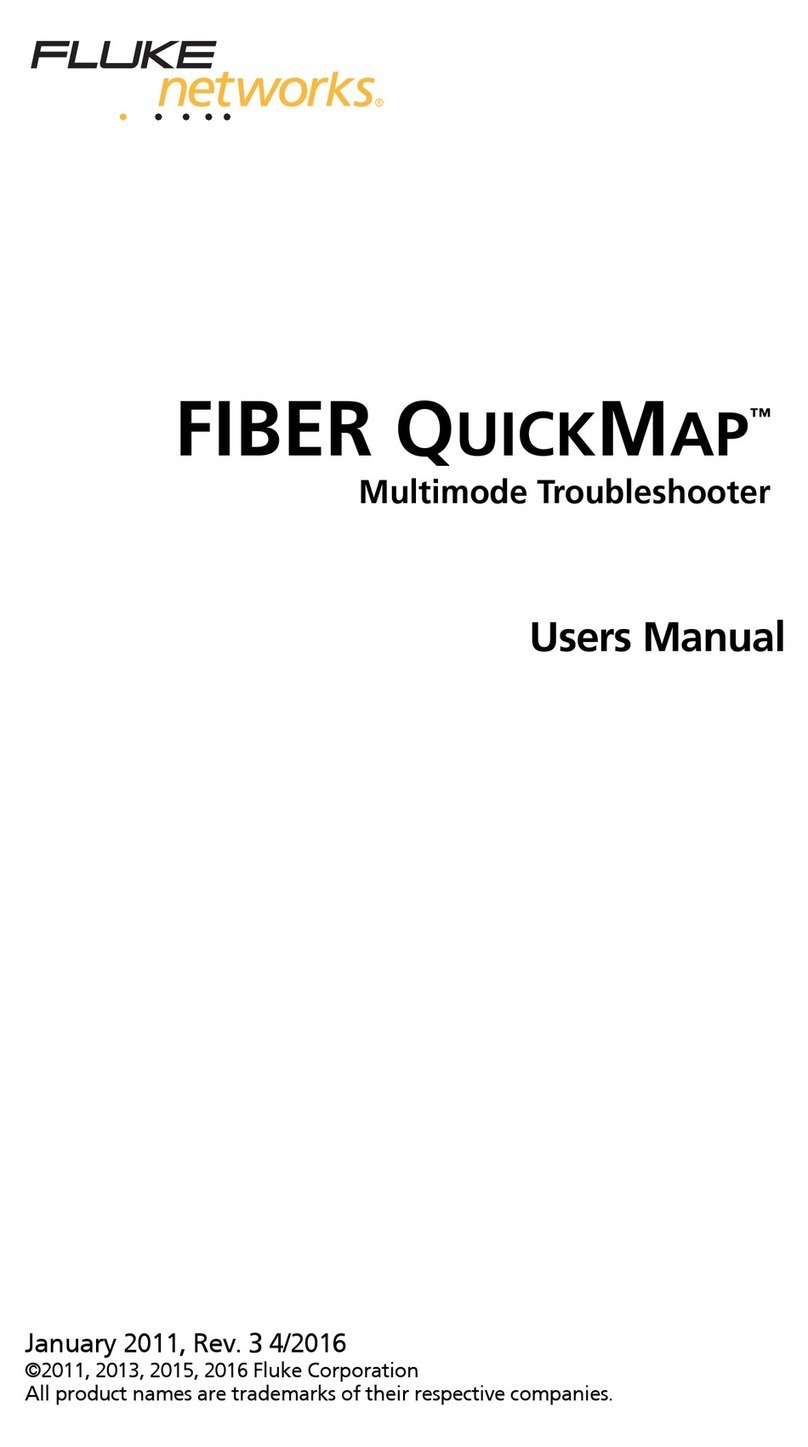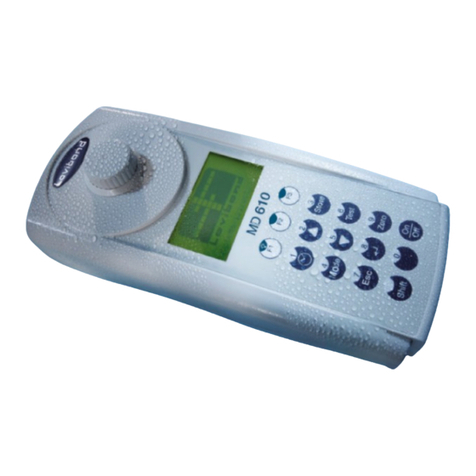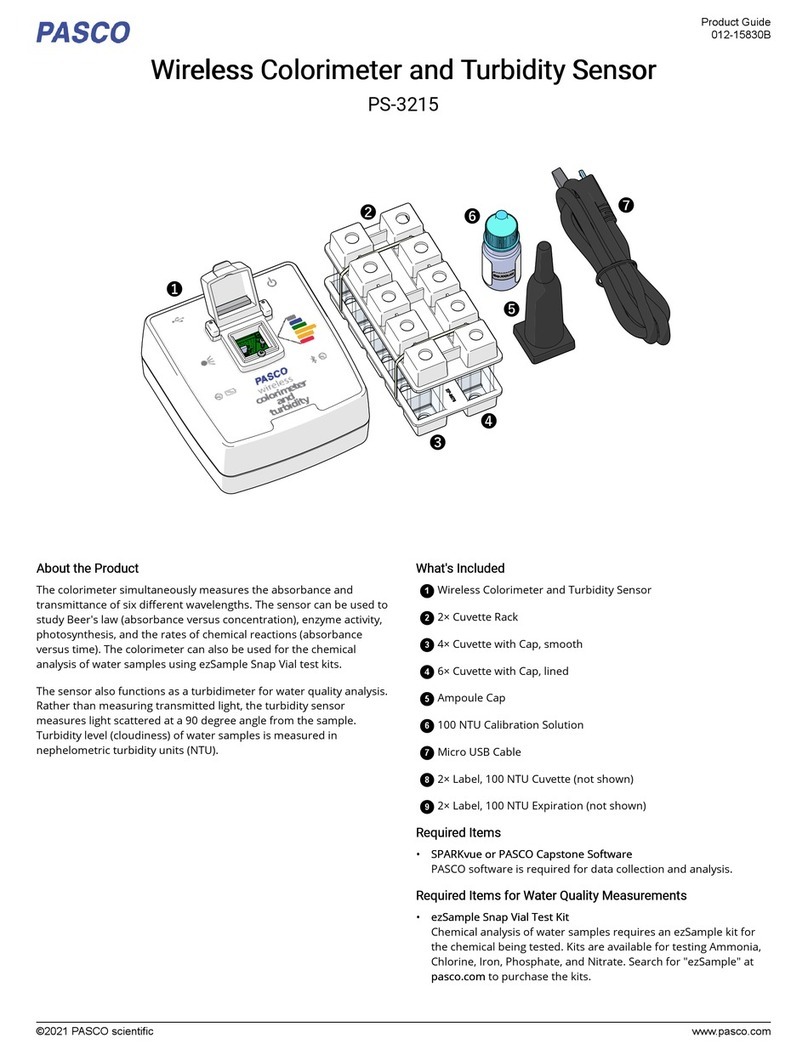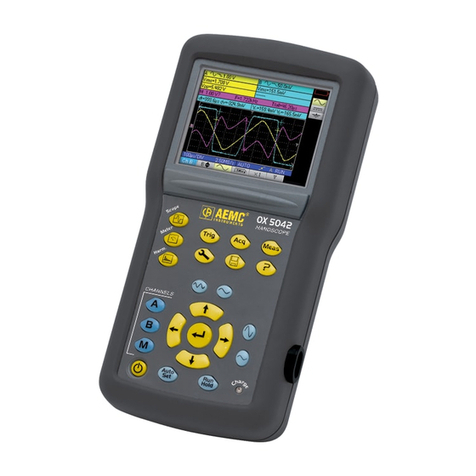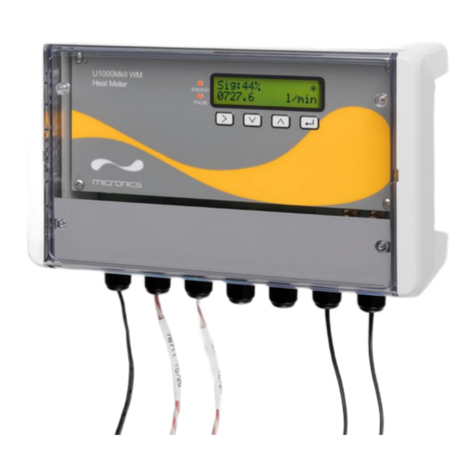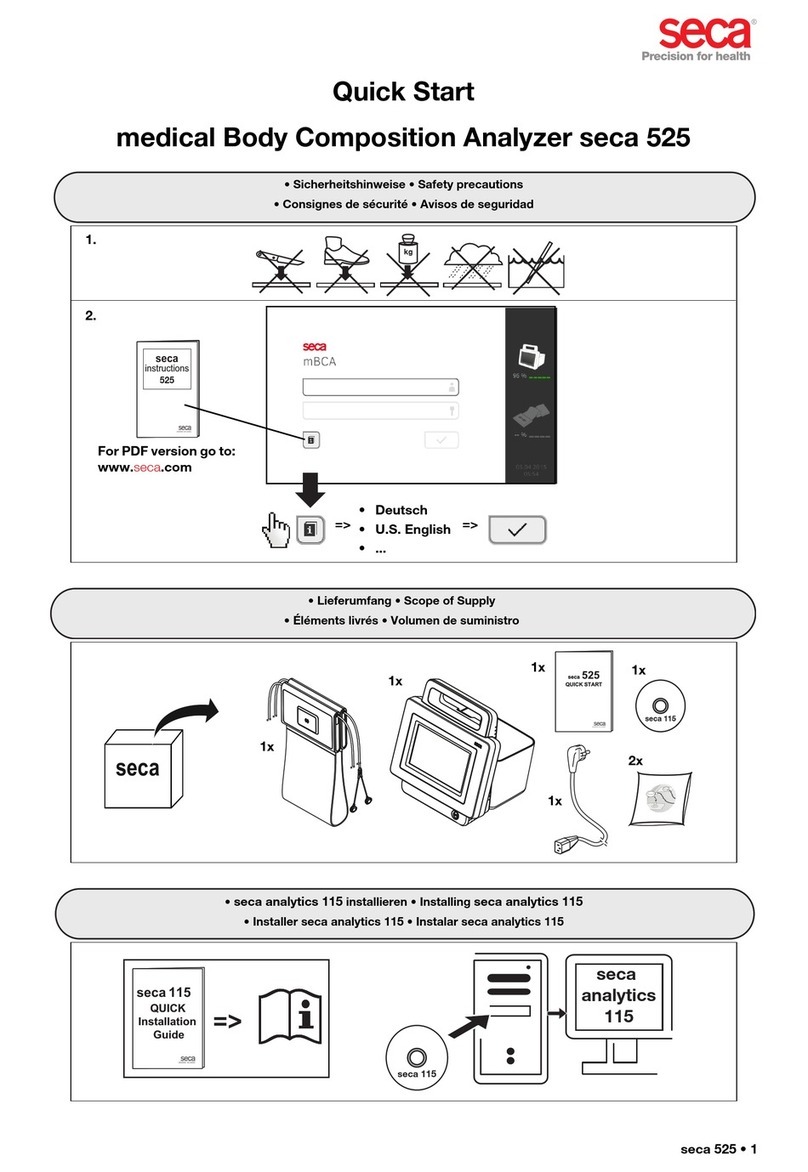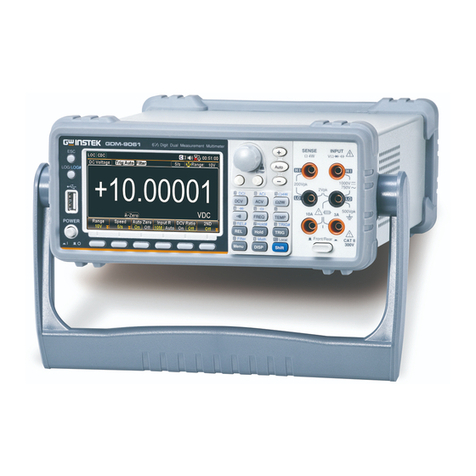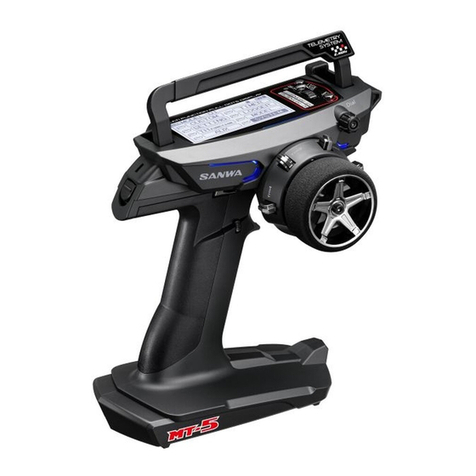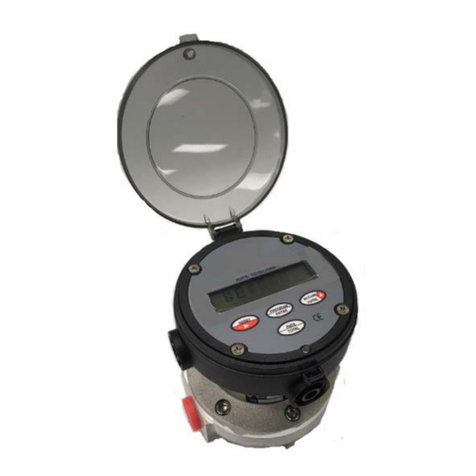Thermo Electron PURE WATER Orion 1817LL User manual

Analyze •Detect •Measure •Control™
Orion Low-Level
Chloride Monitor
INSTRUCTION MANUAL
test
values
mV
slope
E
0
enter
/
done
sample test program
error
cal.
cal
point 1
cal
point 2
three
pt. cal.
complete
cal
point 3
˚C
ppb
error
stable
ppm
sample
values
PURE WATERTM
Monitors
Orion 1800 series
release latches to access
Orion 1817LL

AQUAfast, Cahn, EZ Flash, Ionalyzer, ionplus, KNIpHE, No Cal, ORION, perpHect, PerpHecT, PerpHecTion, pHISA, pHix, pHuture, Pure Water, Sage, Sensing the Future,
SensorLink, ROSS Ultra, Sure-Flow, TEA Analyzer, Titrator PLUS, TURBO2 and Wine Master are registered trademarks of Thermo Electron Corporation.
1-888-pHAX-ION, A+, All in One, Aplus, AQUAsnap, AssuredAccuracy, AUTO-BAR, AUTO-CAL, AUTO DISPENSER, Auto-ID, AUTO-LOG, AUTO-READ, AUTO-STIR, Auto-Test,
BOD AutoEZ, Cable-Free, CERTI-CAL, CISA, DataCOLLECT, DataPLUS, digital LogR, DirectCal, DuraProbe, Environmental Product Authority, Extra Easy/Extra Value, FAST QC,
Flash Titration, Flash Titrator, GAP, GLPcal, GLPcheck, GLPdoc, ISEasy, KAP, LabConnect, LogR, Low Maintenance Triode, Minimum Stir Requirement, MSR, NISS, One-Touch,
One-Touch Calibration, One-Touch Measurement, Optimum Results, Pentrode, pHuture MMS, pHuture Pentrode, pHuture Quatrode, pHuture Triode, Quatrode, QuiKcheK,
rf link, ROSS, ROSS Resolution, SAOB, Smart CheK, Stacked, Stat Face, The Enhanced Lab, ThermaSense, Triode, TRIUMpH, Unbreakable pH, Universal Access are
trademarks of Thermo.
Guaranteed Success and The Technical Edge are service marks of Thermo.
PerpHecT meters are protected by U.S. patent 6,168,707.
PerpHecT ROSS are protected by U.S. patent 6,168,707.
ORION Series A meters and 900A printer are protected by U.S. patents 5,108,578, 5,198,093, and German patents D334,208 and D346,753.
Sure-Flow electrodes are protected by European Patent 278,979 and Canadian Patent 1,286,720.
ionplus electrodes and Optimum Results solutions are protected by US Patent 5,830,338.
ROSS Ultra electrodes have patents pending.
ORION ORP Standard is protected by US Patent 6,350,367.
ORION Series A conductivity meters are protected by US Patent 5,872,454.
© Copyright 2003, Thermo Electron Corporation. All rights reserved. Question everything, and Analyze. Detect. Measure. Control are trademarks of Thermo Electron
Corporation.
The specifications, descriptions, drawings, ordering information and part numbers within this document are subject to change without notice.
This publication supersedes all previous publications on this subject.

I. General Information 1
Introduction 1
Principles of Operation 1
Principles of Calibration 2
Sample Requirements 3
Description of Orion 1817LL Monitor 4
II. Instrument Preparation 7
Unpacking Orion 1817LL and Cooler 7
Mounting, Plumbing and Wiring of
Monitor and Cooler 8
Installation of Reagent and
Diffusion Tubing 9
Installation of Chloride Electrode 10
Installation of Reference Electrode 11
Installation of ATC Probe 11
Flow Regulation 11
III. Instrument Operation 13
Description of Basic Unit Controls 13
Start Up/ Normal Instrument Operation 13
Initial Instrument Set-Up 14
Use of Test Mode 14
Error Mode 15
Shutdown and Start-Up Procedure 16
Flow-Off 16
IV. Instrument and Operation of Modules 17
Signal Conditioner Module 17
Removing Installed Module 17
Replacing Installed Module 17
Setting Module Output 17
Electrical Connections 18
Description of Signal Conditioner Module 18
Programming Measuring Range 19
Optional Alarm Module 20
Installation 20
Setting Alarm Output 20
Electrical Connections for Alarm Module 21
Description of Alarm Module Controls 22
Alarm During Calibration 22
Alarm After Power Failure 22
Setting Alarms 1 and 2 22
V. Calibration 23
Three-Point Calibration Procedure 24
One-Point Calibration Procedure 24
Off-line Calibration Procedure 24
VI. Instrument Maintenance 25
Weekly Maintenance 25
Monthly Maintenance 25
Bi-Monthly Maintenance 26
Yearly Preventive Maintenance 27
VII. Troubleshooting 28
VIII. Repair and Service 31
IX. Notice of Compliance 33
X. Declaration of Conformity 35
XI. Warranty 37
XII. Ordering Information 39
XIII. Appendix 41
Resetting Computer 41
Mounting Dimensions 42
Mounting Recommendation
and Dimensions 43
XIV.QC Sampler Installation
and Operational Procedure 44
Introduction 44
Principles of Operation 44
XV. Specifications of Orion 1817LL 45
XVI. Specifications of QC sampler 46
TABLE OF CONTENTS


Introduction
This manual covers the operation, maintenance and
troubleshooting for the Orion 1817LL which
incorporates the software features of a three point and
off-line calibration.
The Orion 1817LL has a limit of detection of 10±5 ppb.
Used to monitor boiler water and boiler blow down, the
Orion 1817LL is an indicator that could detect costly
condenser leaks. A refrigeration unit cools the sample
down below 12 ˚C which enables the sensor to detect
chloride at extremely low levels without additional
manipulation of the sample. This system includes a
new reference electrode, a double junction ceramic frit
electrode designed to provide outstanding long term
performance; and a chloride sensor known for its
superior accuracy at low levels.
Figure 1:
Block Diagram of Sample Flow
Principles of Operation
Figure 1 is a block diagram of sample flow through
the monitor. Figure 2 illustrates the sample flow
during normal operation.
As shown in Figure 2 the sample (temperatures up to
45 ˚C) enters the Series 1800 Monitor and passes
through the inlet valve, 1, bypass filter, 2, pressure
regulator, 3, flow valve, 4, flow meter, 5, and restrictor
tubing, 6, and then flows through the fluid connector
block, 7, into a reagent diffusion bottle, 8, where the
sample is acidified. Once acidified, the sample flows
to a refrigeration unit, 9, that cools the sample to 5-15
˚C ± 1 ˚C. and the sample is then transferred to the
flow cell, 10, through insulated tubing. Within the flow
cell the cooled sample passes the chloride-sensing,
11, and reference electrode, 12, in the top portion of
the flow cell. The sample then flows past the
temperature probe, 13, into an atmospheric drain, 14.
Figure 2:
Flow During Normal Operation
Legend
1. Inlet Valve 9. Refrigerated Bath
2. Bypass Filter 10. Flow Cell
3. Pressure Regulator 11. Sensing Electrode
4. Flow Valve 12. Reference Electrode
5. Flowmeter 13. Temperature Probe
6. Flow Restrictor Tubing Bottle 14. Drain
7. Fluids Block 15. Electrolyte Reservoir
8. Reagent Diffusion Bottle 16. Bypass Valve
1
I. GENERAL INFORMATION
temperature
probe
reference
probe
sensing
probe
calibration
level
measuring
level
reagent
addition
system
refrigerated
bath
drain
bypass
valve
calibration
injection
port
restrictor
flowmeter
flow
valve
pressure
regulator
bypass
filter
inlet
valve
5
15
11
12
13
4
3
2
6
16
1
14
PURE WATER™MONITORS
1800 series
releaselatches to access
test
values
mV
slope
E
0
enter
/
done
sample test program
error
cal.
add
std1
add
std. 2
three
pt.cal.
complete
add
std. 3
˚C
ppb
error
stable
ppm
sample
values
10
9
8
7

2
Principles of Calibration
Calibration procedures for analytical instruments are
important and must be performed carefully. The Orion
1817LL employs a two-segment calibration method to
cover a wide range of concentrations, the first
segment versus the concentration, and the second
segment versus logarithm of the concentration. The
calibration is carried out at three chloride levels,
concentration being in the ranges of
0-20, 75-125, and 100-10000 ppb from low to high.
The first chloride level can be the “zero chloride”
solution, the second and the third levels can be
generated by introducing known chloride
concentration with the dynamic calibrator through the
injection port. Calibration parameters of both
segments are computed by the microprocessor, and
effects from temperature fluctuation are constantly
corrected. Based on the potential measured in the
sample solution, the microprocessor is makes a
judgment of which segment of calibration is to be used
to read the chloride concentration.
Response of the Low-Level Chloride Electrode
The U.S. patented chloride electrode responds to
changes in chloride ion concentration. This response
is described as follows:
The sensing surface of the electrode consists of the
mixture of a metal amalgam and a sparingly should be
chloride salt of the metal. In samples free of mercury
ions, the potential of the electrode is determined by
the solubility of the salt, which depends on the
temperature and the chloride concentration of the
sample.
At low levels of chloride (< 125 ppb), the electrode
responds approximately linearly to the changes of
chloride concentration at high levels of chloride
(> 75 ppb), the electrode responds logarithmically to
the changes of chloride concentration in a Nernstian
manner. The response can be characterized by the
following equations:
Low levels: E = E0(T) + S1(T)* (C-C2)
High levels: E = E0(T) + S2(T)* log(C/C2)
where: E =measured electrode potential
E0(T) =temperature dependent
potential value
S1(T), S2(T) =temperature dependent slope
values
C=concentration (activity) of
chloride ion
C2=concentration (activity) of
chloride ion of the second
standard.
The monitor calls for a three-point calibration to
determine the actual values of all the parameters and
then enables measurements of chloride at all low and
high levels.
In order to achieve the low detection limit, the monitor
incorporates a cooling system to reduce the sample
temperature. The monitor also uses its
microprocessor to constantly update temperature
corrections from data supplied by the ATC probe.

3
Off-line Calibration
The off-line calibration feature of Orion 1817LL allows
the user to adjust the monitor to values determined by
alternate methods used in their laboratory, such as ion
chromatography and colorimetric method. It is
essentially a one-point calibration. To perform off-line
calibration, a sample is taken from the bypass of the
instrument; the sample value is stored in memory; the
sample is analyzed by an alternate method of choice;
the previously stored reading is adjusted to the lab
method result; and the instrument is then returned to
the analysis mode. The term “off-line calibration”
refers only to the fact that a sample from Orion
1817LL bypass is taken “off-line” for laboratory
analysis; in fact, no downtime is experienced during
the procedure and the instrument remains on-line
throughout.
Three-Point Calibration
This procedure provides maximum calibration
accuracy and requires use of dynamic calibrator,
Orion 15DC15, 115 V or 15DC20, 220 V. In addition to
calculation of electrode E0as is done in
off-line calibration procedure, this procedure
determines electrode slope.
To perform a dynamic three-point calibration, the
Orion 1817LL is first connected to a chloride-free
sample stream. This can be taken at the first standard
of zero chloride. An appropriate diluted standard is
then prepared. A supplied syringe is filled with diluted
standard and mounted on the calibrator. The calibrator
is then mounted near the monitor and the syringe
tubing connected to the standard injection port. By
adjusting calibrator pump settings, two different flow
rates produce two known standards diluted into the
sample background. By pressing the appropriate keys
on the monitor when prompted, the monitor’s
microprocessor completes the calibration.
If a mistake is made or problems occur during
calibration, an error light will come on and alert the
operator. By pressing the error key, the operator can
access information on the display to help determine
the problem.
One-Point Calibration
A quick one-point calibration may be run using the QC
Sampler (18GRAB). See QC Sampler Installation
and Operational Procedure section for details.
Sample Requirements
Sample inlet connection - 1/4” NPTF. If particulate
matter is present in sample, prefiltration is necessary.
Moderate amounts of particulates will be removed by
the 60 micron stainless steel filter located after
inlet valve.
Flow rate — 40 mL/min. nominal
Pressure — 8 - 100 psig. Consult Thermo Electron for
details on sample handling if pressure is
outside range.
Temperature — Temperature must be between
5 - 45 ˚C.
Chloride level — Chloride levels are read directly in
ppb or ppm, when calibrated with Orion Standard,
Orion 941707.
Sample alkalinity — Sample alkalinity acidity should
not be more than 50 ppm CaCO3equivalent. For
higher sample alkalinity, contact the Thermo Electron
Technical Service Department.

4
Description of Orion 1817LL
NOTE: Numbers in the description
refer to Figure 3.
Sample Inlet Valve (1) — Accepts the sample stream
via 1/4 inch NPTF connector. The customer must
supply the sample with a pressure between 8 and
100 psig, and a sample flow rate to the analyzer of
50 mL/min. minimum.
Bypass Filter Assembly (2) — 60 micron stainless
steel filter traps particulate matter in sample stream.
Pressure Regulator (3) — Adjusts flow on incoming
sample stream.
Flow Valve (4) — Used to turn off flow to flow cell.
Flow Meter (5) — Measures sample flow rate.
40 mL/min. nominal flow is required through the
analyzer.
Flow Restrictor Tubing (6) — Maintains steady
sample flow rate in conjunction with pressure
regulator.
Fluid Connector Block (7) — Connects reagent
diffusion bottle to sample stream and flow cell
assembly.
Reagent Diffusion Bottle (8) — Acidifies and adds
iodine to the sample by means of passive diffusion.
Refrigerated Bath (9) — Cools the sample stream to
below 10 ˚C.
Flow Cell (10) — Contains reference electrode,
sensing electrode, ATC probe and sample
measurement reservoir.
Chloride Electrode (11) — Senses chloride ions in
sample stream and produces an electrical potential
dependent on sample concentration.
Reference Electrode (12) — Provides a constant
reference potential and completes the measurement
circuit. Must be placed in right hand side of flow cell.
ATC Probe (13) — Measures sample temperature
and inputs data to microprocessor for automatic
temperature compensation (ATC).
Drain (14) — Atmospheric drain prevents back
pressure on reference electrode located behind
reagent bottle.
Electrolyte Reservoir (15) - Provides a constant flow
of electrolyte solution through reference electrode for
maximum stability.
Bypass Valve (16) — Used to throttle flow in bypass
system located behind reagent bottle.
LED Display (17) — Provides digital readouts of
concentration, temperature, millivolts and error codes.
Keypad (18) — Consists of five mode keys, four
prompt indicator lights, two scroll keys and one key for
entering data. Mode and error indicators are also
incorporated on keypad.
On/Off Switch (19) — Controls all power to the
electronics.
Standard Injection Port (20) — Allows connection of
dynamic calibrator tubing to fluid connector block
during two-point calibration.
Thumbscrew (21) — Supports the reagent diffusion
bottle.
Compression Fitting (22) — Connects flow restrictor
tubing to flow meter.

5
Figure 3:
Major Components of Low-Level Chloride Monitor
test
values
mV
slope
E
0
enter
/
done
sample test program
error
cal.
cal
point 1
cal
point 2
three
pt. cal.
complete
cal
point 3
˚C
ppb
error
stable
ppm
sample
values
6
15
22
11
12 17
18
19
13
5
4
10
3
22
2
7
8
9
14
1
16
20
PURE WATERTM
Monitors
Orion 1800 series
release latches to access

6

7
Unpacking Orion 1817LL
Report any obvious damage of shipping container
to carrier and hold for inspection. The carrier (not
Thermo Electron) is responsible for any damage
incurred
during shipment.
1. Open outer box. Remove foam corner support
pieces.
2. Open inner box and remove cardboard retaining
shell. Remove accessory boxes (4 pcs.) and
instruction manual.
3. Unbolt the monitor from mounting board. Save all
hardware for use during installation.
4. Carefully place the monitor at a convenient
location. Do not pull or lift instrument by its fluidic
components.
Unpacking Refrigeration Unit
1. See manufacture’s instructions before removing
unit from box.
2. Place cooler within five feet of Orion 1817LL for
proper installation.
II. INSTRUMENT PREPARATION
Figure 4:
Unpacking Orion 1817LL

8
Mounting And Plumbing Instructions
1. Select a site for the instrument that allows it to be
permanently bolted (in an upright position) with
ample height for atmospheric drain operation and
ready access to to both electronic controls. The
analyzer location must permit connection to a
plumbed in sample line, a drain, an AC power
supply and any connections for output devices.
2. The analyzer should be mounted as close to the
sampling point as possible, this ensures the
fastest possible response to a changing sample
condition.
3. Prepare mounting holes. Carefully lift the analyzer
and bolt into place. Do not lift the instrument by
holding on to any of the plumbing or fluid
handling components.
4. Connect a waste line to a drain of sufficient
capacity, 0.5 inch (1.27cm) OD is recommended.
5. Connect sample line to the 0.25 inch (0.635 cm)
NPTF stainless steel inlet. It is recommended that
a shut of valve be installed at the sampling point.
Electrical Connection Instructions
1. Remove the protective plastic, front panel inside
the cabinet by unscrewing the 4 holding screws.
Remove the protective plastic plug at the bottom
of the cabinet and feed the AC power line through
the hole.
2. Set voltage (from underside of analyzer) to either
115V or 230V (factory default setting is 115V).
3. Connect AC power according to wiring diagram
below.
4. All electrical wiring feeding through the chassis of
the cabinet must pass through appropriate
electrical fittings in order to maintain the design
integrity of the splash proof cabinet housing the
analyzer electronics. As different types of fittings
may be required at various installations, this feed
through is to be supplied by the user.
WARNING: A grounded metal conduit is
required for FCC compliance.
5. Replace the protective plastic front panel when
complete.
WARNING: Failure to replace the protective
plastic front panel will result in a potential
shock hazard.
Figure 5:
Electrical Wiring of 1800 Series Monitors
(Brown) Hot Line in
Ground
Green/Yellow
Line In
AC Power
Inlet
(Blue) Common Line in
Voltage Selector (115V/230V)
(Switched from Underside
of Instrument)
Power ON/OFF
(Switched from Underside
of Instrument)

9
Cooler Connection Instructions
1. Open the bag which contains the tubing
components. The bag should contain 10 feet of
1/4” plastic tubing, 5 feet of foam tubing insulation,
and two 1/4-3/8 union compression fittings.
2. Cut the plastic tubing into two five-foot lengths.
Ensure that the cut is straight, and the tubing end
is smooth and undamaged.
3. Remove the nut from the unused compression
fitting on the back of the fluids block, and slide it
over the end of one of the pieces of plastic tubing.
Leave about one inch of tubing protruding from
the end of the nut, as shown in Figure 6.
4. Insert the tubing into the hole of the compression
fitting until it cannot be pushed any further. Then,
slide the nut back over the threads of the fitting
and tighten while holding the tubing in place.
5. Remove the nut from the unused compression
fitting on the back of the flow cell, and slide it over
the end of the other piece of plastic tubing. Leave
about one inch of tubing protruding from the end
of the nut, as shown in Figure 6.
6. Insert the tubing into the hole of the compression
fitting until it cannot be pushed any further. Then,
slide the nut back over the threads of the fitting
and tighten while holding the tubing in place.
7. Remove the larger nut from one of the union
compression fitting, and slide it over the end of
one of the rigid tubing outlets on the lid of the
refrigerated bath. Leave about one inch of tubing
protruding from the end of the nut, as shown in
Figure 6.
8. Slide the compression fitting over the rigid tubing
until it cannot be pushed any further. Then, slide
the nut back over the threads of the fitting and
tighten while holding the compression fitting
in place.
9. Repeat steps 7 and 8 for the other compression
fitting.
10. Slide the free end of the plastic tubing connected
to the flowcell into the insulation tubing. Push the
insulation tubing down the length of the plastic
tubing until it cannot be pushed any further.
11. Push the free end of the foam insulation back,
exposing about two inches of plastic tubing.
Remove the smaller nut from one of the union
compression fitting on the lid, and slide it over the
end of the exposed plastic tubing. Leave about
one inch of tubing protruding from the end of the
nut, as shown in Figure 6.
12. Insert the tubing into the hole of the compression
fitting on the lid until it cannot be pushed any
further. Then, slide the nut back over the threads
of the fitting and tighten while holding the tubing in
place.
13. Remove the smaller nut from the unused
compression fitting on the lid, and slide it over the
free end of the other length of plastic tubing.
Leave about one inch of tubing protruding from
the end of the nut, as shown in Figure 6.
14. Insert the tubing into the hole of the compression
fitting on the lid until it cannot be pushed any
further. Then, slide the nut back over the threads
of the fitting and tighten while holding the tubing in
place.
Figure 6:
Picture to be updated in the future

10
Installation Of Reagent And Diffusion
Tubing
WARNING: Formic acid is hazardous. Use
protective glasses and gloves. Refer to
bottle label for precautions.
1. Support the bottom of the reagent bottle. Turn
thumbscrew, counterclockwise to release diffusion
bottle. Unscrew white bottle cap and gray tubing
connector assembly. (Keep bottle supplied with
instrument as a spare.)
2. Take a new bottle of reagent to a well-ventilated
area such as a laboratory fume hood. Unscrew
and remove white cap.
3. Connect diffusion tubing (use Orion 181060
ONLY) to tubing connector assembly to conform
to Figure 7. Place the tubing assembly and cap
into the bottle.
4. Replace gray cap and screw white cap on tightly.
5. Insert the five nipples on the top of the reagent
diffusion bottle into the fluid connector block, as
shown in Figure 7.
6. Support the bottom of the reagent bottle with one
hand and tighten the thumbscrew clockwise.
Installation of Chloride Electrode
1. Unpack chloride electrode (Orion 100025) and
carefully remove protective cap. Save cap for
future storage of electrode.
2. Insert chloride electrode into sensing hole of flow
cell cap. See Figure 3. Sensing electrode is
placed in the hole to the right of the divider seen in
flow cell and the hole closest to the electronics
cabinet.
3Connect electrode to cable marked “Sens. Elect.”
4. Wait at least one hour before calibrating analyzer.
View Front Left Side of Analyzer
Figure 7:
Reagent Diffusion Bottle Assembly
tubing
barbed fittings
reagent
diffusion
bottle
white cap
nipples with
small O-rings
gray cap with
large O-ring
tubing should be connected
to right-hand barbed fittings
only(as seen from the front)
fluid connector
block
Front
Injection Port

11
Installation of Reference Electrode
1. Unpack reference electrode, 7, (Orion 100057)
and tubing from shipping box. Remove protective
caps from bottom and sidearm of electrode. Save
caps for future storage of electrode. Inspect
internal of electrode (item 7 in Figure 8). Verify it
is at least half filled with the internal fill solution. If
not, replace the electrode.
2. While passing 1/8 inch tubing, 31, into electrode
through sidearm, slide 1/4 inch tubing, 32, over
sidearm. The outside tubing should extend
3/8-1/2 inch over sidearm.
3. Remove cap and fluid seal from Orion 900063
electrolyte fill solution bottle, 33. Hold bottle in
upright position. Check that rubber gasket, 34, is
properly aligned, then connect cap end of tubing
assembly to bottle. The 1/8-inch tubing should
extend into the bottle.
4. Hold reservoir above electrode with bottle cap end
down. Electrode should be horizontal with sidearm
pointing up. Gently shake electrode to allow any
trapped air bubbles to rise into bottle as electrode
fills with solution.
5. Dry off ceramic frit on base of electrode with
tissue paper. Squeeze bottle for a few seconds. A
small amount of filling solution should bead up on
frit surface, indicating good electrolyte flow. If no
moisture is visible, electrode is clogged and
should be replaced.
6. Invert electrolyte bottle and snap into clip, 35. Use
push pin supplied to puncture three air vents on
bottom of bottle.
CAUTION: Failure to vent electrolyte bottle
will lead to noisy and drifty readings.
7. Connect electrode to electronic chassis by
“keeper cable” labeled “Ref. Elect.” Insert
electrode into reference hole in flow cell cap. See
Figure 3.
Figure 8:
Reference Electrode Assembly
Installation Of ATC Probe
The automatic temperature compensation (ATC)
probe is already connected to the electronics housing.
Insert into remaining hole of flow cell cap.
Flow Regulation
When the Orion 1817LL Monitor is first commissioned,
it is advisable to flush out fluidics system overnight
prior to initial calibration and use. The electronics need
not be turned on at this time. Refer to Figure 3.
1. Open sample inlet valve, 1.
2. Pull out red locking ring of pressure regulator, 3,
then adjust black knob so that ball of flow meter
reads 40 mL/min. Push in red locking ring to
secure the setting.
3. Open bypass valve, 16. Check for appropriate
sample flow. Readjust pressure regulator if
required.
4. Wait at least one hour before calibrating analyzer.
35
33
34
31
32
30
7

12

13
Description of Basic Unit Controls
On/off switch - Controls power to all electronics and
air pump. It is located on electronic chassis bottom
and includes an integral circuit breaker.
LCD display - Displays four-and-one-half digit plus
polarity sign used to read concentration, slope, E0
millivolts, temperature, error messages, and
diagnostic information.
Mode indicating LED — (Located to left of LCD
display.) Indicates range (ppb or ppm), error codes,
and electrode stable in sample mode. Displays
temperature (°C), millivolts, electrode slope, and E0on
LCD in test mode.
Prompt indicating LED — Prompts the user during
calibration. Four LED’s located in keypad region are
used. These are: cal point 1; cal point 2; cal point 3;
three pt. cal complete.
▲and ▼ keys — Increases or decreases displayed
values that can be operator-changed such as alarm
level, analog output range, off-line calibration, and
blank correction values.
Enter/done key — Enters value displayed on LCD
into “permanent” memory for later use. Key also
indicates to microcomputer that a required calibration
step has been completed.
Sample key — Puts Series 1800 Monitor into sample
mode and (re) activates any optional modules. This is
also its default mode, e.g., instrument automatically
enters sample mode when first turned on and after
calibration.
Cal key — Starts Series 1800 Monitor into calibrate
mode. Operator is then prompted through the steps
necessary for calibration.
Test key — Places Series 1800 Monitor into test
mode where LCD displays temperature, millivolts, E0
and slope. Each successive push of key, steps
instrument through this sequence, and an LED on the
left of display indicates value displayed.
Error — If error LED is lit (soft error), then pressing
key causes LCD to display an error code. Note, in the
case of “hard error,” LCD would cease to display
normal output but would display error code only. Refer
to Error Code Table.
Program key — Used to program expected
calibration concentrations for three point calibration,
and used in conjunction with Cal key for off-line
calibration. Also used to display the low range
calibration slope.
Figure 9:
Front Panel Keypad
Start Up/Normal Instrument Operation
1. Install the Orion 1817LL Monitor according to
instructions in INSTRUMENT PREPARATION.
Power supply should be wired for proper voltage
and instrument suitably grounded.
2. Turn on flow at sample inlet and flush for at least
one hour.
3. Power up Orion 1817LL by toggle switch on
bottom of electronics case. See Figure 3.
4. Observe air bubbling through liquid in flow cell.
LCD will display following information sequence:
a. + 1.8.8.8.8;
b. 1817 while LEDs sequentially light;
(NOTE: Mode indicating LEDs and test LED on
modules are not tested during start-up
sequence.)
c. Revision number of software program
(e.g., -x.y-)
5. After completion of steps 1-4, the Monitor is now
in normal operational mode “sample.”
III. INSTRUMENT OPERATION
test
values
mV
slope
E
0
enter
/
done
sample test program
error
cal.
cal
point 1
cal
point 2
three
pt. cal.
complete
cal
point 3
˚C
ppb
error
stable
ppm
sample
values

14
Initial Instrument Set-Up
Before first sample measurements on Orion 1817LL
can be performed, calibration concentration
increments must be programmed into memory. See
Table 1 below. P2 and P3 values shown are based on
use Orion 941707 100 ppm Chloride standard.
Table 1
Program Key Table
Code Meaning
P0 1-point cal concentration
P1 Low arrange slope
P2 3-point cal standard 2 concentration
P3 3-point cal standard 3 concentration
P4 3-point cal standard 1 concentration
1. Press program key until the LCD displays P2.
The current value for the second calibration
concentration increment will be displayed. Default
value is 100 ppb.
2. Change this value by using keys marked ▲and
▼. Press enter/done key to store appropriate
value in memory.
3. Press program key until the LCD displays P3.
The current value for the third calibration
concentration increment will be displayed. Default
value is 1 ppm.
4. Change this value by using ▲and ▼. Press
enter/done key to store appropriate value in
memory and unit will automatically return to
sample mode.
5. Press program key until the LCD displays P4.
The current value for the first calibration
concentration increment will be displayed. Default
value is 0 ppb.
6. Change this value by using ▲and ▼. Press
enter/done key to store appropriate value in
memory and unit will automatically return to
sample mode.
7. Battery backup of memory will maintain
programmed variables for at least one month if
battery is fully charged.
Use of Test Mode
When test key is pressed, the LCD displays
temperature, millivolts, high range, slope and E0.
Every time the test key is pressed the monitor steps
through this sequence. An LED to the left of display
indicates value displayed.
If test mode is entered from sample mode, then
sample and test LED are lit. If test mode is entered
from calibration mode, then calibrate and test LED are
lit. Note that while LCD displays test information, the
instrument still continues normal sampling or
calibration sequence. Therefore, when sample and
test modes are pressed, signal conditioning and
optional alarm modules are active. When calibrate and
test modes are pressed, calibration prompt LEDs will
light as usual.
To exit test mode press sample or calibrate key as
desired. LCD will now display instantaneous
computed concentration.
If sample key is pressed while in the calibration mode,
the current calibration will abort with no data saved.

15
Error Mode
The Orion 1817LL Monitor diagnoses two types of
errors which are termed “hard” and “soft.” In the event
of hard error, the analyzer cannot compute any
meaningful concentration values, error LED will be lit
and LCD will display an error code. The signal
conditioner module will indicate zero scale and alarms
will be deactivated. Hard error must be corrected prior
to resumption of normal operation (E40 and E50) by
performing a complete calibration.
If error LED is active but instrument continues to
display concentration, this is termed “soft” error. Soft
error can affect accuracy and/or precision of displayed
concentration but not interfere with instrument’s ability
to compute sample concentration. To determine cause
of soft error, press error key and LCD will display
error code.
Table 2
Error
Code Meaning
E00 No errors
E01 Default values are used. The monitor has not
been calibrated since start-up or the reset
button was pushed.
E02 Sample is outside the temperature range of
5 - 45 ˚C, or: the cooled sample is outside the
temperature range of 0 - 15 ˚C.
E03 Combination of E01 and E02
E04 Faulty ATC probe, or related circuitry
E05 Combination of E01 and E04
E10 After calibration the new slope is outside
expected range
E20 Calibration due. Last calibration performed
30 days ago. A reminder to perform another
calibration.
E30 Calibration due and slope error. This indicates
that the last calibration was performed at least
30 days ago and the electrode slope was out
of specification at that time.
E40 Calibration overdue. It has been at least
6 weeks since the last calibration. The
instrument beyond this point could be out of
specification. This is a hard error. The only
way to exit this error is to perform a complete
three point or off-line calibration. (Blank
correction will not affect this error code.)
E50 Calibration overdue and slope error. This
indicates that it has been at least 6 weeks
since the last calibration and the electrode
slope was out of specification at that time. The
instrument beyond this point could be out of
specification. This is a hard error. The only
way to exit this error is to perform a complete
three point or off-line calibration. (Blank
correction will not affect this error code.)
The most common error codes are combinations of
the above codes, but other errors may be displayed:
E12 E10 and E02
E14 E10 and E04
E21 E20 and E01
E22 E20 and E02

16
Shutdown And Start-Up Procedure
The following steps should be taken if a loss of sample
flow is expected for more than one day. These
procedures will prevent possible build-up of acidic
reagent vapors in the analyzer.
NOTE: At cycling power plants or on units
where sample flow to the monitor is
frequently interrupted, the installation of a
backup sample is recommended. Connect a
suitable high purity water source (such as
condensate storage tank) into the sample
line just upstream of the monitor’s sample
inlet. By putting shutoff valves in both
sample and backup lines at this point,
backup or actual sample flow can be
quickly valved in or out as required. In this
way, continuous flow to the monitor can be
supplied and the need for the following
startup/shutdown, equilibration and
recalibration procedures is eliminated.
(Note, however, that for sample flow loss of
only a few hours, monitor recalibration
should not be required.)
Shutdown
1. Shut off sample flow prior to the analyzer inlet.
2. Turn off power.
3. Drain flow cell.
DANGER: Shut off power switch at base of
monitor before beginning procedure;
otherwise, the air pump will spatter acid
reagent outward as bottle is removed.
WARNING: Wear rubber gloves and safety
goggles to avoid possible injury from
reagent residues in the system.
4. Remove reagent bottle and store in a well
ventilated area such as a laboratory fume hood.
5. Carefully pull chloride and reference electrodes
out of the top of the flow cell and let them hang by
their connectors. Locate protective end cap from
reference electrode kit and place on base of
reference electrode. This will prevent the
reference electrode from drying out.
Start-up
1. Replace the diffusion tubing if sample flow has
been off for more than a few days. Tubing
becomes brittle with long term exposure to
reagent. Use a fume hood and wear rubber gloves
and safety goggles for this procedure. If age of
reagent is not known, replace it and note in
maintenance records. Re-install bottle on
analyzer.
2. Polish chloride electrode according to instructions
found with Orion 151713 polishing strips which are
included with 100025 chloride electrode.
3. Restore sample flow to analyzer. If necessary,
adjust pressure and flow rate through analyzer to
normal ranges.
4. Remove protective end cap from reference
electrode. Re-install electrode on analyzer being
careful not to disconnect reservoir tubing from
sidearm.
5. When meter reading stabilizes (about one hour),
recalibrate according to Calibration.
Flow Off
If the analyzer is expected not to have flow for time
periods of less than twenty-four (24) hours, leave the
instrument on and neglect its output.
If the time is expected to be greater than twenty-four
hours, follow Shutdown procedures.
Table of contents
Other Thermo Electron Measuring Instrument manuals

Thermo Electron
Thermo Electron Polysonics SX40 User manual
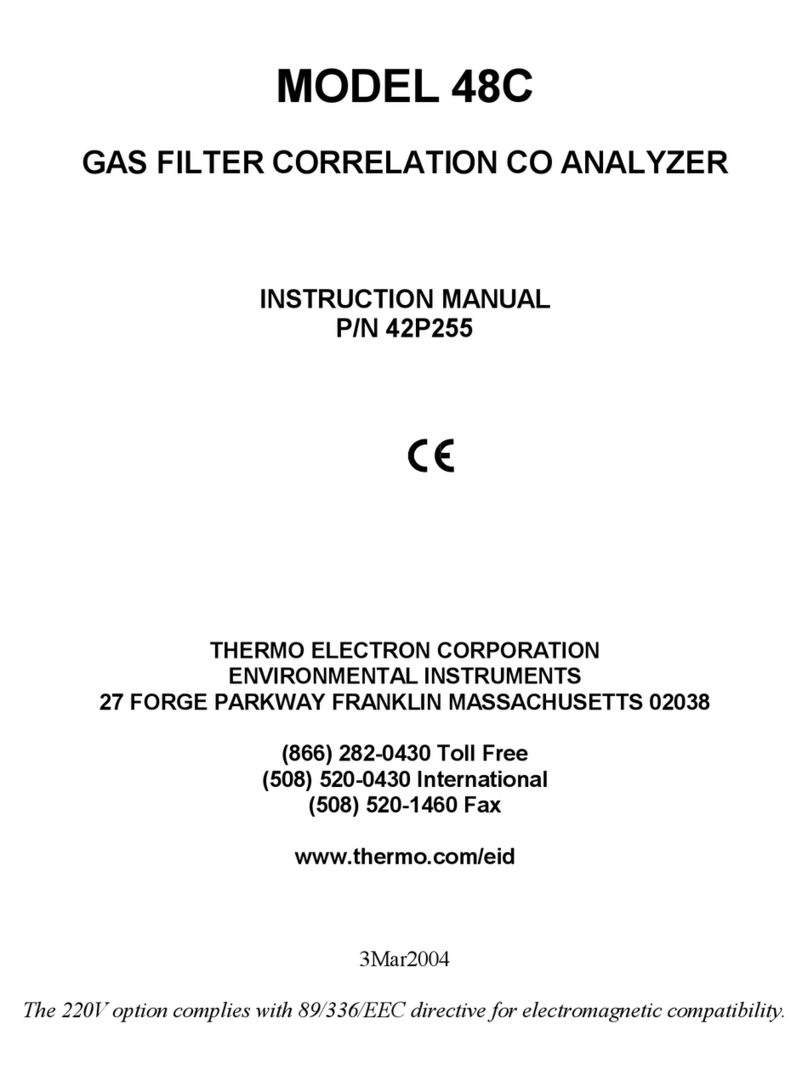
Thermo Electron
Thermo Electron 48C User manual
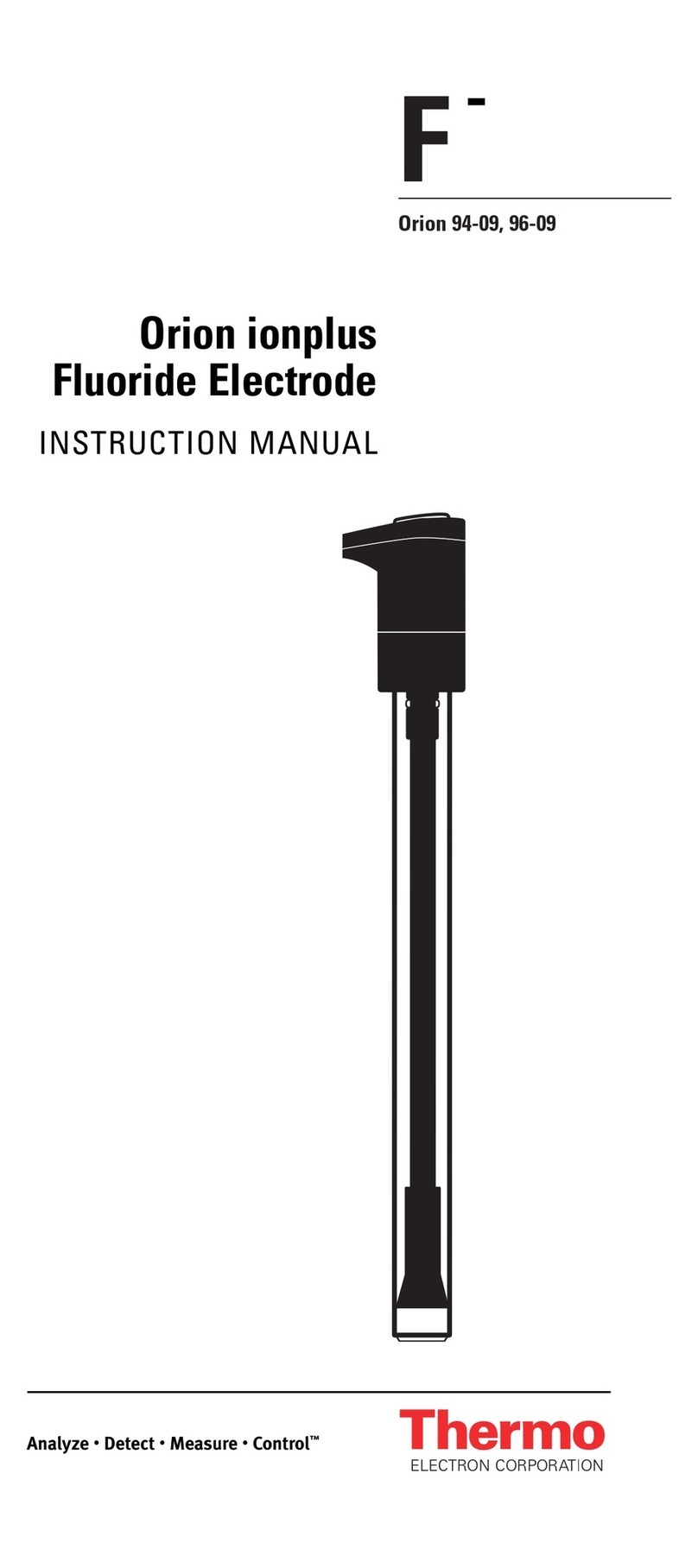
Thermo Electron
Thermo Electron 96-09 User manual
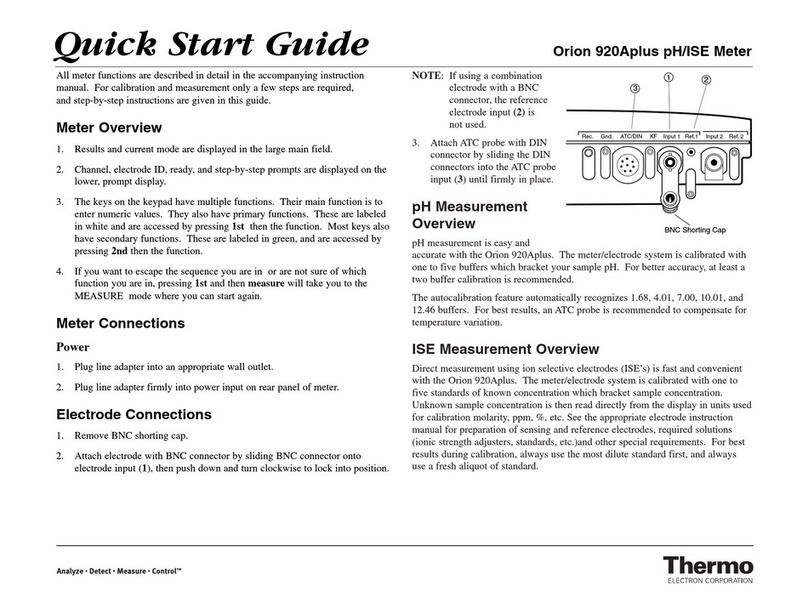
Thermo Electron
Thermo Electron Orion 920Aplus User manual

Thermo Electron
Thermo Electron Orion Star Series User manual
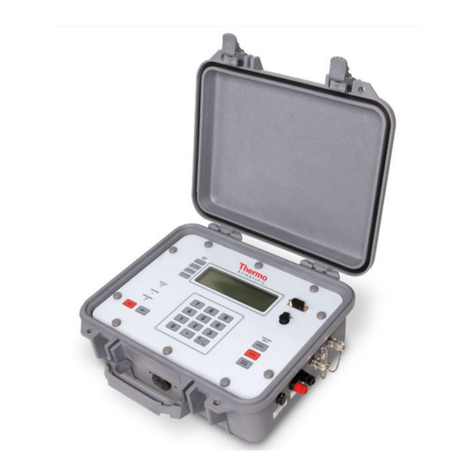
Thermo Electron
Thermo Electron Polysonics SX30 User manual
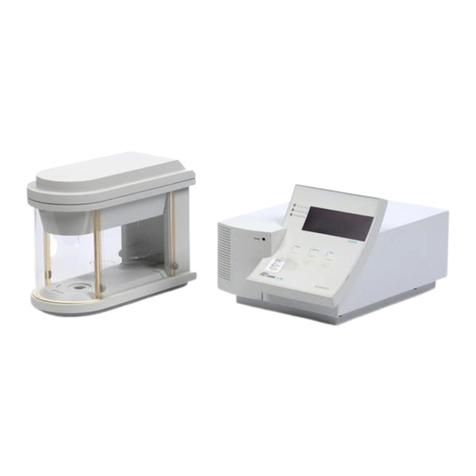
Thermo Electron
Thermo Electron Cahn C-34 User manual
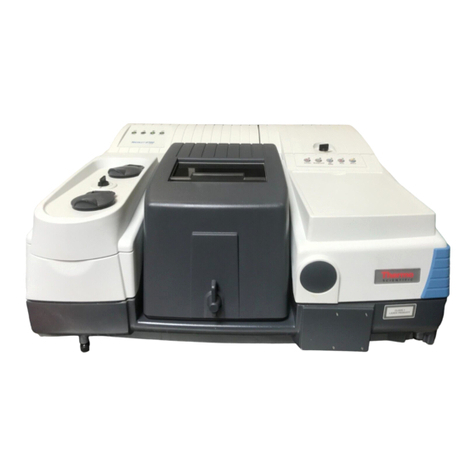
Thermo Electron
Thermo Electron Nicolet 4700 User manual

Thermo Electron
Thermo Electron Nicolet 380 User manual
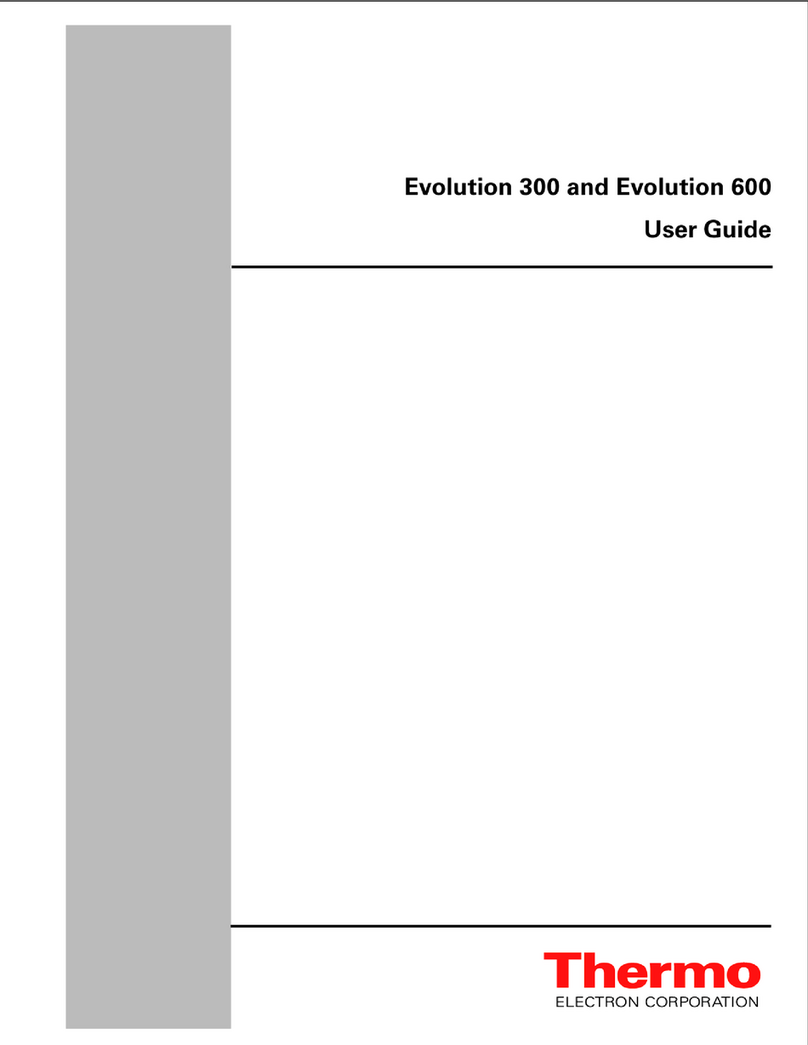
Thermo Electron
Thermo Electron Evolution 300 User manual
